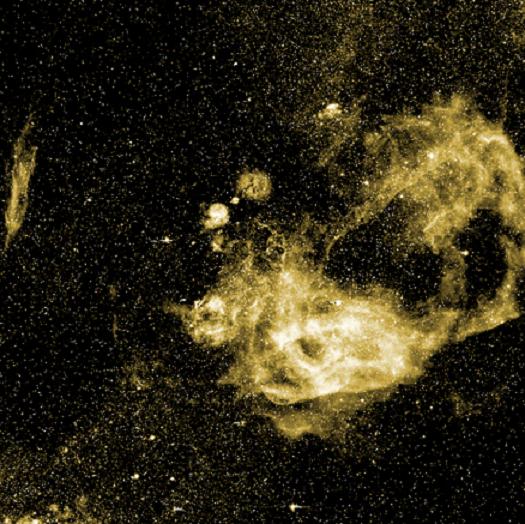Magnetic Monsters
Nov 26, 2008
Extreme magnetic fields in space
are said to be caused by the
high-speed rotation of neutron
stars. One of many cases where a
theory is built on the incorrect
assumptions of another theory.
Several
Picture of the Day articles have
addressed the problem of neutron
stars and how they affect the
progress of astronomical
investigation. According to electric
star theory, neutron stars belong in
the same category with invisible
pink unicorns. Deficits in
gravity-only cosmology made the
neutron star hypothesis necessary in
order to defend gravity's ostensibly
endless powers.
Neutron
stars were proposed as the answer to
pulsar behavior. Pulsars are stars
whose brightness fluctuates over a
short period of time. Pulsars are
important to astrophysical models
because they are used as measuring
tools. Those with "known" distance,
coupled with variations in their
luminosity, are thought to be road
markers in space, so that the
distances of other stars with
similar characteristics can be
determined.
Pulsars
are described as "light houses" with
beams of energy concentrated at
specific points. Consensus
gravitational theory demands that
any new information conform to the
tenets of the theory rather than the
other way around, so a rotational
mechanism was proposed for the
pulsations. When the spin of a
pulsar brings its beam inline with
telescopes on Earth, a flash of
light is visible.
However,
when the rotation rates of some
pulsars were measured at once per
second or less (even with many times
the mass of our Sun), "neutron
stars" were fabricated. Only a super
dense material like neutronium was
thought able to withstand those
rotational speeds. Neutronium is a
hypothetical material that has had
all of its electrons smashed down
into the nuclei, where the protons
and electrons combine into neutrons.
"Magnetars"
are anomalous stars identified as
x-ray pulsars (AXP) or soft gamma
repeaters (SGR). They are said to be
created by neutron stars with
magnetic fields measuring over 10^15
Gauss. For comparison, the Earth's
magnetic field is about one-half
Gauss, so these "magnetic pulsars"
are surprisingly powerful sources.
It must be stressed, though, that
the evidence is indirect and no
neutron star has ever been observed.
What is
observed are intense magnetic fields
sometimes pulsing in a fraction of a
second. Some magnetars have also
been detected emitting gamma ray
bursts ascribed to “star quakes” in
the ultra-hard surface of the
neutron star. Because the mass per
unit volume is so great, any rapid
movement in the crust generates
intense "magnetic reconnection,"
thereby producing gamma rays. It is
not necessary to reiterate the
problems with magnetic reconnection
except to say that it is also one of
the class of imaginary constructs
created by astrophysicists in an
attempt to explain energetic events
without sufficient gravity
It is a
well-established fact that magnetic
fields are induced by electric
currents. Therefore, there must be
an electric current generating the
intense fields in the magnetar. It
is also indisputable that the feeder
current must be part of a circuit,
since persistent electric current
must flow in a completed circuit.
The
Electric Universe hypothesis
requires no collapsed stars or
rotational speeds so great that
ordinary matter could never take the
strain. The oscillations in
magnetars (or pulsars, in general)
are caused by resonant effects in
electric circuits. The sudden
release of stored electrical energy
in a “double layer” is responsible
for the occasional outburst of gamma
rays. The outburst begins with a
sudden peak of energy, and then
declines gradually, like a stroke of
lightning.
Don
Scott, author of
The Electric Sky, recently
wrote: "The 'neutron star' is simply
yet another fantasy conjured up,
this time, in order to avoid
confronting the idea that pulsar
discharges are electrical phenomena.
A nucleus or charge free atom made
up of only neutrons has never been
synthesized in any laboratory nor
can it ever be. In fact, a web
search on the word 'neutronium' will
produce only references to a
computer game—not to any real,
scientific discussion or
description. Lone neutrons decay
into proton/electron pairs in less
than 14 minutes; atom-like
collections of two or more neutrons
will fly apart almost
instantaneously."
It seems
more likely that we are witnessing
in magnetars an immense
concentration of electricity being
focused by some kind of "plasma
gun." As the current flows through
clouds of dusty plasma it
concentrates forces because of the
Biot-Savart effect, drawing
itself together and forming helical
zones of immense compression known
as "z-pinches" or "Bennett pinches."
Stars form in the compression zones,
and depending on how much current is
flowing through the circuit the
star's magnetic field will be
greater where there is more current.
By Stephen Smith
|







